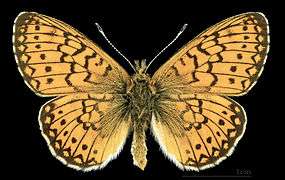Boloria eunomia
| Boloria eunomia | |
|---|---|
 | |
| Scientific classification | |
| Kingdom: | Animalia |
| Phylum: | Arthropoda |
| Class: | Insecta |
| Order: | Lepidoptera |
| Family: | Nymphalidae |
| Genus: | Boloria |
| Species: | B. eunomia |
| Binomial name | |
| Boloria eunomia Esper, 1799 | |
| Synonyms | |
| |
The bog fritillary or ocellate bog fritillary (Boloria eunomia) is a butterfly of the Nymphalidae family.

Description
The wings are orange-brown with dark markings. The color of the hindwings are orangish-brown with a tan postmedian band followed by a row of round silver spots. The length of the forewings is 20–24 mm. The butterfly may be threatened by bog hydrology.[1] The males search for females in wet areas.[2] The butterfly has the subspecies triclaris (from Newfoundland to Alberta), nichollae (Alberta), and denali (Alaska and northern Yukon). The butterfly flies close to the ground.[3] The species is listed as vulnerable.[4] They eat nectar from flowers including Labrador tea and goldenrod.[2] The species flies from the end of May till the beginning of August.[4] The butterfly can be distinguished from similar species by looking on the hindwing underside; this species is the only one with a row of silvery submarginal spots.[5]
-

Dosal side
-

△ Ventral side
Habitat
It is found throughout the north-temperate region of the Northern Hemisphere[5] including the Balkan Mountains of Bulgaria and one isolated population in Serbia.[6] The species is not mentioned in the Red Data Book of Serbian butterflies because it was not known to be in the country at the time of it being published.[6] The species is commonly found in open acid bogs in areas that are moist.[1] It can also be found in moist tundra and willow seeps.[2]
Caterpillars
The eggs are laid in groups of 2 to 4 under the host plant leaves.[2] When the eggs hatch in 7 to 8 days and after hatching, they feed on the underside of the leaves on the host plant. Caterpillars in Colorado and Wyoming are reddish-brown with red spines, with third or fourth instars hibernating. The caterpillars feed on Viola species and willows.[5] The caterpillars can be found from April to June.[7] The caterpillars are silver-gray with white dots.[3]
Behavior
Mating System and Migration
Proclossiana eunomia exhibits a polygynous mating system which is quite common in butterflies with short breeding periods.[8] With breeding periods of 5 and 7 respectively for males and females, there is little time to maximize matings. The butterfly Proclossiana eunomia wants to pass on as many genes as it can in its short lifespan and thus males do not discriminate, trying to court all females they encounter. On the other hand, females are a bit more selective and have been observed to refuse incoming males either by displaying a mate-refusal posture or by simply fleeing away.[8]
This pattern of mating affects the migratory behavior of Proclossiana eunomia. This physical moving of individual of a species is dependent on the density of the population. At high male densities females are harassed by willing males, resulting in female-biased emigration where females leave the imminent area. At low male densities, females are not bothered and are safe to stay in their local environment. In addition, at low female densities males might begin to emigrate out of the area in search for new unmated females whereas at high female density males already enjoy a wide selection of females without a need to migrate. The polygynous mating system of the Bog Fritillary whereby males freely pursue females induces a change in migratory behavior.[8]
References
- 1 2 "Bog Fritillary (Boloria eunomia)". Wisconsin Department of Natural Resources. Retrieved 2010-05-24.
- 1 2 3 4 "Bog Fritillary Boloria eunomia (Esper, 1800)". Butterflies and Moths of North America. Retrieved 2010-05-24.
- 1 2 "Bog Fritillary Boloria eunomia (Esper, 1800)". Canadian Biodiversity Information Facility. Retrieved 2010-05-24.
- 1 2 "Boloria eunomia (Esper, 1799)". Catalogue of the Lepidoptera of Belgium. Retrieved 2010-05-24.
- 1 2 3 "Species Page - Boloria eunomia". Entomology Collection. Retrieved 2010-05-24.
- 1 2 "Boloria eunomia". Prime Butterfly Areas: A tool for nature conservation in Serbia. The Butterfly Conservation Europe and Serbian NGO HabiProt. Retrieved 2010-05-24.
- ↑ Thomas J. Allen; James P. Brock; Jeffrey Glassberg (2005). Caterpillars in the field and garden: a field guide to the butterfly caterpillars of North America. Oxford University Press US. p. 82. ISBN 978-0-19-514987-6.
- 1 2 3 Baguette, Michel (1998). "Sex-biased density-dependent migration in a metapopulation of the butterfly Proclossiana eunomia". Acta Oecologica. 19 (1): 17–24.
External links
| Wikimedia Commons has media related to Boloria eunomia. |